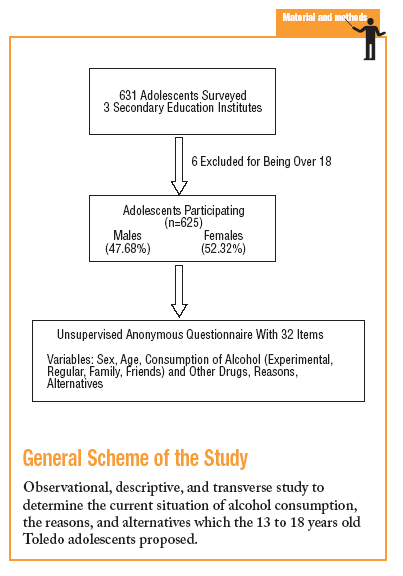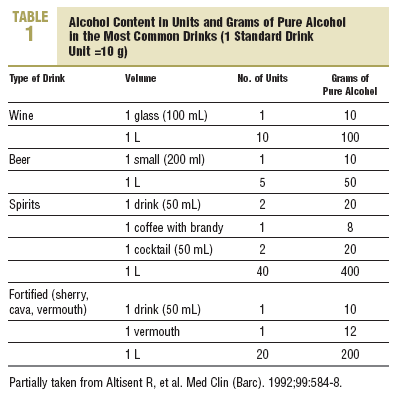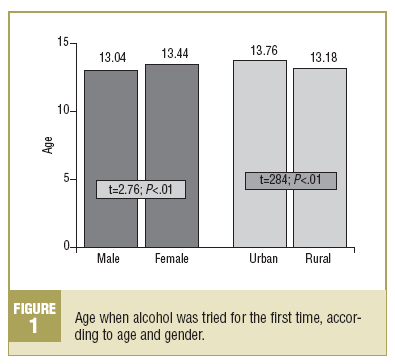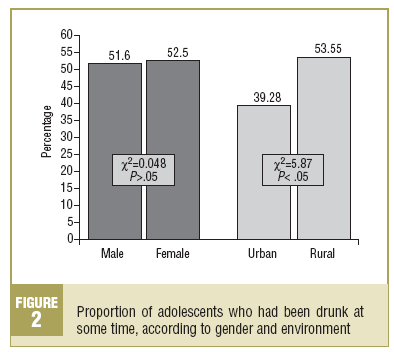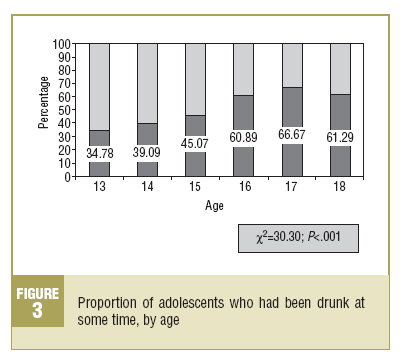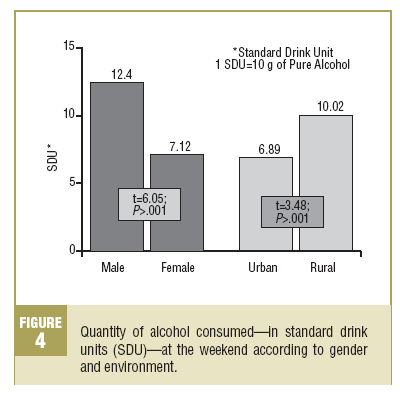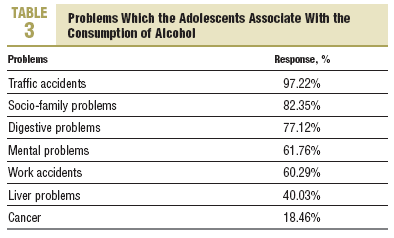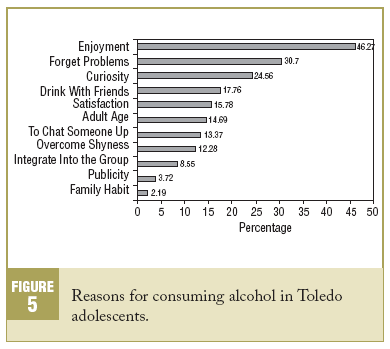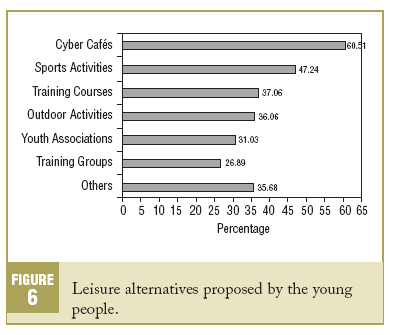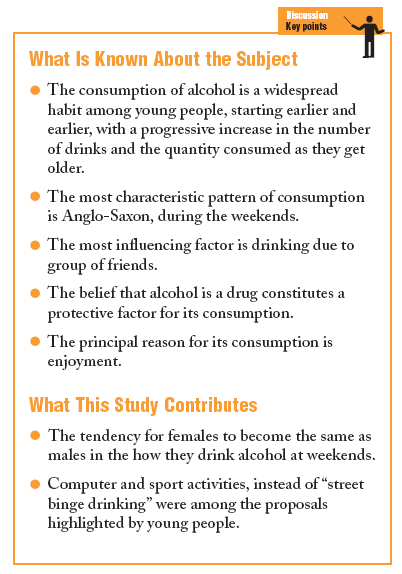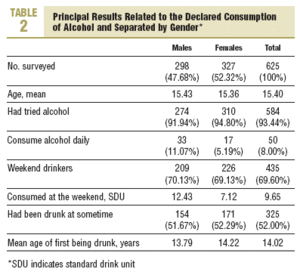Introduction
Excessive alcohol consumption causes inevitable diseases and premature death,1,2 it is associated with more than 40%-50% of traffic accidents, a principal cause of death among young people and adolescents,2 it increases family conflict, delinquency, and socio-health costs,3 and decreases performance at school.4 Alcohol is a drug, cheap, legal, permitted, accessible and accepted by society.5 Several studies detect a first contact at continually lower ages.6-8
"Street binge drinking" (consuming a large amount of alcohol in a short time, in the street, at the weekend) is the pattern that young people follow, imitating Anglo-Saxon consumption.9 It represents a way of integrating into the group,2 and a means of enjoyment due to the lack of alternative leisure time activities.
Of the existing studies on the consumption of alcohol in young people, few analyse the reasons, whose consideration could promote efficient preventive policies, as reflected in the Survey on Drugs in the School Population of 2002.10 For this reason, this study tries to establish the current state of consumption in Toledo adolescents and the alternatives they proposed, with the aim of making more effective interventions.
Patients and Methods
An observational, descriptive and transverse study was carried out in 2 health zones of the Toledo health area in May 2003. The study population was made up of schoolchildren in the third and fourth years of Obligatory Secondary Education and the first year of High School (Bachillerato), between 13 and 18 years old, who were studying in 2 secondary education institutes in Torrijos and one in Toledo city. All were given an anonymous questionnaire, designed ad hoc, which they completed during school hours, with 32 questionsthe majority closed --relating to: age, sex, experimental and regular consumption of alcohol, consumption by family and friends, quantity consumed --in standard drink units (SDU); I SDU is equivalent to 10 g of pure alcohol (Table 1)-- knowledge and sources of information on alcohol, taking of other drugs (legal and illegal), reasons for the consumption, and the alternatives to "street binge drinking." The statistical analysis was carried out using the R-SIGMA program, applying the Pearson *2 test for qualitative variables and the Student t test for the quantitative ones.
Results
Of the 631 adolescents who completed the questionnaire, 6 were rejected for being over 18 years old. There were no refusals to participate in the study.
Of the 625 questionnaires which were finally analysed, 298 (47.68%) were male and 327 (53.32%) were female. The mean age and standard deviation was 15.4±1.3 years. The principal results relating to the declared consumption of alcohol are separated by sex and are shown in Table 2.
93.44% (95% Confidence Interval [CI], 91.12-95.19) of those questioned had experimented with drinking alcohol, in which 50% had done so before the age of 14 years, with no significant differences by sex or environmental origin. The mean age in which alcohol was tried was 13.25 years (95% CI, 13.11-13.39). The age of first trying was earlier in males and in the rural environment (Figure 1).
52.0% (95% CI, 48.0-56.13) stated having been inebriated at some time, without differences by sex, although there was in the environmental origin (Figure 2), a percentage which grew with increasing age (Figure 3). At 16 years, more than half had been drunk at some time, the mean age of the first being drunk was 14.02 years (95% CI, 13.82-14.22).
69.60% drank regularly at weekends (95% CI, 65.84-73.31), especially rum mixed with cola (cubatas) (74.70%), beer (56.56%), and wine (37.47%). The mean amount of alcohol ingested during the whole weekend was 9.65 SDU (95% CI, 8.78-10.52), being higher in males and in the rural environment (Figure 4). The young people from rural areas drank more in bars (67.89%) than in the street (56.53%), while those in the urban areas preferred the street (76.27%) to the bar (45.76%). 8% consumed alcohol daily (95% CI, 6.05-10.48), which was significantly more frequent in males than in females (11.07% vs 5.19%; *2=6.52; P<.05), with no differences as regards rural and urban environments.
Family consumption was 28.89% and in the friends group it was 90.80%, there being an association between this and the consumption of alcohol at weekends (*2=56.55; P<.001).
56.06% (95% CI, 54.09-61.97) considered alcohol as a drug, with no differences by sex or environmental origin. 52.09% believed that drinking 4 small beers per day was not much. The problems which they associated with the consumption of alcohol are shown in Table 3. The sources of information most mentioned were: school (69.88%), parents (67.10%), and the media (62.03%).
As regards the consumption of other toxic substances, 31.92% (95% CI, 27.65-35.02) smoked, the girls more so (*2=7.37; P<.001), with a significant relationship between this habit and the consumption of alcohol at weekends (*2=67.02; P<.001). Of the illegal drugs most tried, smoking cannabis occupied first place (34.4%), followed by pills (6.86%), cocaine (5.86%), and heroin (1.34%); these types of substances were not consumed by 63.81%.
Among the reasons for drinking alcohol (Figure 5), "enjoyment" is most common, although they started their drinking for curiosity. Of the alternative leisure activities mentioned (Figure 6) were, particularly, "cyber cafés" and sport activities. More than 75% did not know of the existence of programs started by the Government directed at this group.
Discussion
One of the best ways of getting information on the consumption of alcoholic drinks and its reasons are population based surveys using anonymous unsupervised questionnaires.11 Since alcohol is a legal substance, is socially accepted in our culture and its consumption does not involve any stigma which might determine the sincerity of the responses, except in cases of abuse or dependence,4 we believe in the internal validity of our study. On the other hand, the majority of studies consulted are in line with that found in ours, except precise data which we believe does not alter the external validation.
The consumption of alcohol is a very extensive habit among young people, with a wide range (43.7%-92.13%) of adolescents having tried it.2,4-8,11-14 In our study it was over 93%, which shows an currently increasing trend. The initial contact occurs at 13-14 years, as reflected in the Survey on Drugs in the School Population 2002,10 although there are some references to below 10 years old.2,11 The seriousness of starting this at such early ages lies in the subsequent higher frequency of consumption,15 the adoption of other habits of risk16 and the appearance of organic and/or psychiatric disturbances.17
The ingestion is excessive, as they exceed 80 g in a short period of time at least once a month, therefore they fall into the group of drinkers at risk,18 according to that recommended by the World Health Organisation and the PAPPS (Program of Preventive Activities and Health Promotion).17 With advancing age, the number of drinkers and the amount ingested increases,14 following a Northern European pattern of drinking large quantities during the weekends2,5,8,16,19,20 in bars, pubs, and discotheques,19,21 which explains the frequent drunkenness in adolescents.4,5,12,16,21,22
We did not find significant differences between drunkenness and gender, which made us think that although the consumption is higher (in quantity and frequency) in males,2-4,23 there is a change in female behaviour with alcohol,16 with a tendency equalise with males during weekends.8,14,21,22
There are significant differences between rural and urban environments as regards experimenting, number of drunken episodes and places to drink, perhaps due to more permissive opening hours10 and cheaper drinks in the former. This fact highlights that the risk behaviour of adolescents is influenced by the environment.16,21,22
There is no doubt that to have friends who drink is a significant factor associated with the consumption of alcohol in young people.2,3,10,22,23 Whereas, this is not associated with family drinking,2,4,14 but it is with the family structure,7 as the perception of dissatisfaction in this environment and/or alcoholism in any of the parents has been reported as causal factors of the alcohol abuse in adolescents.24,25 However, although the first consumption takes place in the family environment during parties or celebrations,11 the determining factor is the influence exercised by their group of equals.2,4,14
We are pleased that the school and the family are put forward as sources of information on alcohol, and the communications media for its effects, since, although these may be powerful health brokers, sometimes they create social alarms on being the "season" against it and require the close collaboration of the health authorities to offer truthful information.26 Even then, the information for adolescents is insufficient,7,11,27 as almost half of them believe alcohol is not a drug,4 less than half know the quantity of alcohol/day which is a health risk,12 and only a small percentage believe that it does not produce dependency.6 They have a low perception of the risk connected to a high consumption, perhaps owing to the climate of family and social tolerance which is perceived from childhood,7 along with the minimising of the risks by society and advertising influence.17 However, they do show interest in receiving information, an aspect which coincides with the opinion of the Spanish population as reflected in the Eurobarometer,28 which advocates information campaigns (54.9%) as the first measure in the fight.
The adolescents, a high risk group and highly vulnerable to the damaging effects of alcohol,29 have to know the individual, family and social repercussions of its consumption. The health authorities have not adopted a more active attitude against the problem, as the consumption we found is similar to that in the general population25 and we have an arduous task, which includes: changing the favourable expectations which young people have as regards alcohol (enjoyment, improves social relationships),23 participating in school educational programs which must precede the negative behaviour for health,3,4,6,7,16,30 as primary prevention measures and diagnosing alcohol abuse as soon as possible17 by means of questionnaires or semi-structured interviews31 on frequency/quantity in secondary prevention, and intervention by counselling,1 without forgetting the programs on decreasing the dangers and risks.32
Parents, as central figures of intervention, must create a positive family atmosphere with a rational, controlled and a less permissive model as regards the consumption of alcoholic drinks,10,24 which has been shown to be effective, to which should be added global policies against alcohol which will help the efforts of teachers, parents and health authorities to achieve the proposed objectives as regards young people and alcohol.
In this way, all the alternatives which the young people propose are feasible, if we have the collaboration of the local and regional Administrations. A major effort is all that is needed to disseminate them and make them more accessible to young people.
Finally, we believe that the effectiveness of all the interventions directed at the prevention of alcohol consumption should be studied, with the aim making more valid tools available to reduce and delay it.
Acknowledgements
To Yolanda Sánchez del Viso and Luis Campillo Marcos, for their participation in the collection of information.







